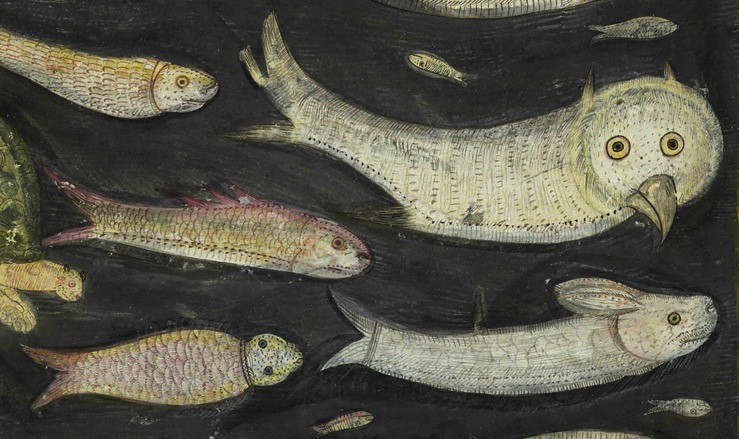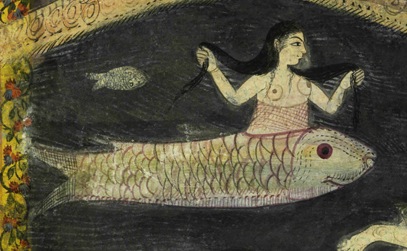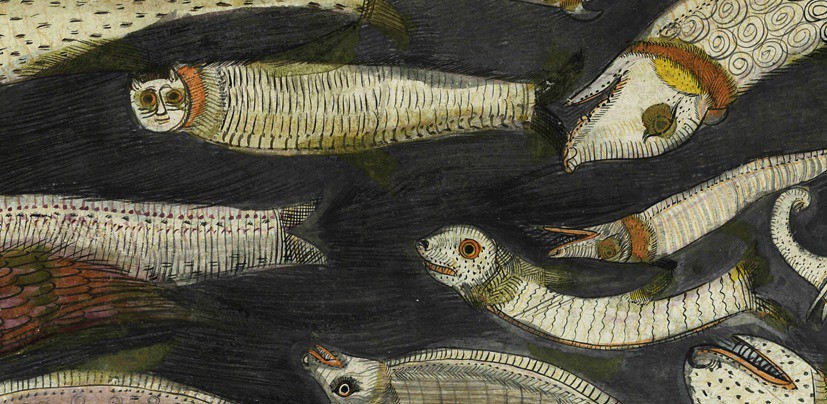Рыба. Книга чудес
Оригинал взят у gorbutovich в Рыба моей мечты. Книга чудес
Средневековая исламская наука. «Чудеса сотворенного и диковинки существующего»

Фрагмент рисунка в иллюминированной рукописи XVII-XVIII века. Закарийа' ал-Казвини. «Чудеса сотворенного и диковинки существующего». Раздел «Семь морей». Перевод с арабского на персидский
Один разворот из иллюстрированной «Книги чудес века», хранящейся в Сент-Эндрюсском университете, Шотландия. Рукопись изготовлена в XVII-XVIII в., язык персидский. 130 бумажных листов размером 40х30 см. Манускрипт состоит их двух частей, скрепленных в один том. Первая часть - сокращенный вариант «Жизни животных» аль-Дамири (1341-1405). Вторая часть - выписки из сочинения Закарийа' ал-Казвини, жившего в XIII веке.
На развороте рукописи - масса причудливых рыб, обитающих в водах большого острова Ghis около Греции. В числе прочих тут рыбы с головами совы, слона, кота, кролика, ежа, человека и прочие странные создания - см. ниже. Всего описано 360 видов рыб.
Рыбная картинка относится ко второй части манускрипта - к тексту ал-Казвини: fol. 91-130: Extracts from the 'Seven Seas' section of 'Aja'ib al-makhluqat (Wonders of Creation) of Qazwini. Cites as authorities 'Abdarrahman ibn Harun al-Maghribi and Abu Hamid al-Andalusi. Picture book with only a line or two of text on each page. Names of places given in Arabic but text in Persian.
Знаменитый космограф и географ Закарийа ибн-Мухаммад ибн Махмуд ал-Казвини (1203-1283) - один из самых популярных арабских средневековых писателей, является автором двух больших пpoизведений. Первое сочинение - космографическое: «Аджа'иб ал-махлукат ва гара'иб ал мауджудат» /«Чудеса творений и диковинки существующего» (часто называют просто «Космография»).
2.

Book of the Wonders of the Age. 17-18th c?. The University of St Andrews, ms32(o), f.99b-100a: island of Ghis, large island near Greece, famous for fish, 360 species described - many with strange heads. Extracts from the 'Seven Seas' section of 'Aja'ib al-makhluqat (Wonders of Creation) of Qazwini. Source
Второе большое произведение ал-Казвини - географическое: «Асар ал-билад ва ахбар ал-'ибад» /«Памятники стран и известия о людях» (сокращенно «География»). В географической энциклопедии, составленной в 1275-1276 гг., ал-Казвини дает описание семи климатов земли, содержащее сведения различных странах, областях, городах, горах, озерах, островах, река и т. д. Ал-Казвини приводит исторические данные о них, а также интересные сведения о выдающихся личностях, выходцах из того или иного населенного пункта.
3.

Book of the Wonders of the Age. 17-18th c?. The University of St Andrews, ms32(o), f.99b-100a: island of Ghis, large island near Greece, famous for fish, 360 species described - many with strange heads. Extracts from the 'Seven Seas' section of 'Aja'ib al-makhluqat (Wonders of Creation) of Qazwini. Source
4.

Book of the Wonders of the Age. 17-18th c?. The University of St Andrews, ms32(o), f.99b-100a: island of Ghis, large island near Greece, famous for fish, 360 species described - many with strange heads. Extracts from the 'Seven Seas' section of 'Aja'ib al-makhluqat (Wonders of Creation) of Qazwini. Source
5.

Book of the Wonders of the Age. 17-18th c?. The University of St Andrews, ms32(o), f.99b-100a: island of Ghis, large island near Greece, famous for fish, 360 species described - many with strange heads. Extracts from the 'Seven Seas' section of 'Aja'ib al-makhluqat (Wonders of Creation) of Qazwini. Source
6.

Book of the Wonders of the Age. 17-18th c?. The University of St Andrews, ms32(o), f.99b-100a: island of Ghis, large island near Greece, famous for fish, 360 species described - many with strange heads. Extracts from the 'Seven Seas' section of 'Aja'ib al-makhluqat (Wonders of Creation) of Qazwini. Source
7.

Many bizarre fish, including a hedgehog-headed fish, an owl-headed fish and a fish with a person coming out of its head. Book of the Wonders of the Age. 17-18th c?. The University of St Andrews, ms32(o), f.99b-100a: island of Ghis, large island near Greece, famous for fish, 360 species described - many with strange heads. Extracts from the 'Seven Seas' section of 'Aja'ib al-makhluqat (Wonders of Creation) of Qazwini. Source
[The Book of the Wonders of the Age. University Library Special Collections, University of St Andrews, ms32(o)]
The Book of the Wonders of the Age. University Library Special Collections, University of St Andrews, ms32(o)
Part of a compilation, comprising two works in Persian, profusely illustrated throughout, front and back covers stamped with stylised sun-head, rebound in 1848. Numbered in Persian. Catchwords.
Part of a compilation, comprising two works in Persian, profusely illustrated throughout, front and back covers stamped with stylised sun-head, rebound in 1848. Numbered in Persian. Catchwords.
f2a. Date of 25 ramazan 1263 within a colourful inscription: 'One thousand beautiful and elegant masked faces are in this society but you are the only one with the true face which is beautiful'.
1. (fol. 3-89b): 'Ain al-Haiyat, or The Substance of the Lives, an abbreviation in Arabic of the famous Haiyat al-Haiyawan or Lives of the Animals of Damiri. The abbreviation was written by Damamini. 'The fifth treatise of the second volume of the Book of Wonders of the Age, or an account of the conditions on land- and sea-animals, comprising a preface and 28 chapters, according to the letters of the alphabet, with the names of animals and descriptions of their peculiarities and an explanation.' The writer has left the translation unfinished or has failed to transcribe completely an earlier Persian version, as it ends with the male partridge instead of ending with the queen-bee.
2. (fol. 91-130): Extracts from the 'Seven Seas' section of 'Aja'ib al-makhluqat (Wonders of Creation) of Qazwini. Cites as authorities 'Abdarrahman ibn Harun al-Maghribi and Abu Hamid al-Andalusi. Picture book with only a line or two of text on each page. Names of places given in Arabic but text in Persian.
The writer has left this part unfinished, some of the illustrations are sketched out but incomplete.
Extent 1 volume, 130ff.
Creator Name: Damiri, Damamini, Qazwini
Admin History: Muhammad Ibn Musa Kamal Ad-din Ad-damiri (1341-1405) was born in Egypt at Damira near Damietta. He became a theologian and an expert in Islamic jurisprudence, as well as Arabic philology, teaching in Cairo and at the mosque of el-Azhar and producing works on Islamic law and natural history. His most famous writing was the Haiyat al-Haiyawan or Lives of the Animals, a compilation of works by many authors to give copious details on the 931 animals mentioned in the Koran, including folklore, proverbs, medical uses and meaning of names.
Damamini was an Egyptian who travelled to the Yemen and then to India, completing his work in Gujarat in AH823/AD1420.
Zakariya' ibn Muhammad al-Qazwini (d.1283), was a Persian physician from Qazvin. He travelled around the Near East serving as a legal expert and judge, including in Baghdad for the governor, 'Ata-Malik Juwayni. Qazwini's popular cosmology was dedicated to the governor. This treatise was first written in Arabic, entitled 'Aja'ib al-makhluqat wa-ghara'ib al-mawjudat (Marvels of Things Created and Miraculous Aspects of Things Existing). He also wrote a geographical dictionary, Athar al-bilad wa-akhbar al-'ibad (Monument of Places and History of God's Bondsmen).
Language: Persian
Physical Description: Paper: 16.5' x 12'.
Источники, дополнительно:
University Library Special Collections, University of St Andrews, ms32(o)
Закарийа' ал-Казвини на сайте «Восточная литература»: Казвини, Закария. Публикация 1976 г. Космография. Публикация 2004 г. Публикация 2002 г. Предисловие. Космография. География.
Ранее из St Andrews ms32(o):
Хипстеры бородатые. Чудеса сотворенного и диковинки существующего
Сложная международная обстановка. XIII век
До и после слона. Атака слонов в год рождения Мухаммада
Средневековая исламская наука. «Чудеса сотворенного и диковинки существующего»

Фрагмент рисунка в иллюминированной рукописи XVII-XVIII века. Закарийа' ал-Казвини. «Чудеса сотворенного и диковинки существующего». Раздел «Семь морей». Перевод с арабского на персидский
Один разворот из иллюстрированной «Книги чудес века», хранящейся в Сент-Эндрюсском университете, Шотландия. Рукопись изготовлена в XVII-XVIII в., язык персидский. 130 бумажных листов размером 40х30 см. Манускрипт состоит их двух частей, скрепленных в один том. Первая часть - сокращенный вариант «Жизни животных» аль-Дамири (1341-1405). Вторая часть - выписки из сочинения Закарийа' ал-Казвини, жившего в XIII веке.
На развороте рукописи - масса причудливых рыб, обитающих в водах большого острова Ghis около Греции. В числе прочих тут рыбы с головами совы, слона, кота, кролика, ежа, человека и прочие странные создания - см. ниже. Всего описано 360 видов рыб.
Рыбная картинка относится ко второй части манускрипта - к тексту ал-Казвини: fol. 91-130: Extracts from the 'Seven Seas' section of 'Aja'ib al-makhluqat (Wonders of Creation) of Qazwini. Cites as authorities 'Abdarrahman ibn Harun al-Maghribi and Abu Hamid al-Andalusi. Picture book with only a line or two of text on each page. Names of places given in Arabic but text in Persian.
Знаменитый космограф и географ Закарийа ибн-Мухаммад ибн Махмуд ал-Казвини (1203-1283) - один из самых популярных арабских средневековых писателей, является автором двух больших пpoизведений. Первое сочинение - космографическое: «Аджа'иб ал-махлукат ва гара'иб ал мауджудат» /«Чудеса творений и диковинки существующего» (часто называют просто «Космография»).
2.

Book of the Wonders of the Age. 17-18th c?. The University of St Andrews, ms32(o), f.99b-100a: island of Ghis, large island near Greece, famous for fish, 360 species described - many with strange heads. Extracts from the 'Seven Seas' section of 'Aja'ib al-makhluqat (Wonders of Creation) of Qazwini. Source
Второе большое произведение ал-Казвини - географическое: «Асар ал-билад ва ахбар ал-'ибад» /«Памятники стран и известия о людях» (сокращенно «География»). В географической энциклопедии, составленной в 1275-1276 гг., ал-Казвини дает описание семи климатов земли, содержащее сведения различных странах, областях, городах, горах, озерах, островах, река и т. д. Ал-Казвини приводит исторические данные о них, а также интересные сведения о выдающихся личностях, выходцах из того или иного населенного пункта.
3.

Book of the Wonders of the Age. 17-18th c?. The University of St Andrews, ms32(o), f.99b-100a: island of Ghis, large island near Greece, famous for fish, 360 species described - many with strange heads. Extracts from the 'Seven Seas' section of 'Aja'ib al-makhluqat (Wonders of Creation) of Qazwini. Source
4.

Book of the Wonders of the Age. 17-18th c?. The University of St Andrews, ms32(o), f.99b-100a: island of Ghis, large island near Greece, famous for fish, 360 species described - many with strange heads. Extracts from the 'Seven Seas' section of 'Aja'ib al-makhluqat (Wonders of Creation) of Qazwini. Source
5.

Book of the Wonders of the Age. 17-18th c?. The University of St Andrews, ms32(o), f.99b-100a: island of Ghis, large island near Greece, famous for fish, 360 species described - many with strange heads. Extracts from the 'Seven Seas' section of 'Aja'ib al-makhluqat (Wonders of Creation) of Qazwini. Source
6.

Book of the Wonders of the Age. 17-18th c?. The University of St Andrews, ms32(o), f.99b-100a: island of Ghis, large island near Greece, famous for fish, 360 species described - many with strange heads. Extracts from the 'Seven Seas' section of 'Aja'ib al-makhluqat (Wonders of Creation) of Qazwini. Source
7.

Many bizarre fish, including a hedgehog-headed fish, an owl-headed fish and a fish with a person coming out of its head. Book of the Wonders of the Age. 17-18th c?. The University of St Andrews, ms32(o), f.99b-100a: island of Ghis, large island near Greece, famous for fish, 360 species described - many with strange heads. Extracts from the 'Seven Seas' section of 'Aja'ib al-makhluqat (Wonders of Creation) of Qazwini. Source
[The Book of the Wonders of the Age. University Library Special Collections, University of St Andrews, ms32(o)]
The Book of the Wonders of the Age. University Library Special Collections, University of St Andrews, ms32(o)
Part of a compilation, comprising two works in Persian, profusely illustrated throughout, front and back covers stamped with stylised sun-head, rebound in 1848. Numbered in Persian. Catchwords.
Part of a compilation, comprising two works in Persian, profusely illustrated throughout, front and back covers stamped with stylised sun-head, rebound in 1848. Numbered in Persian. Catchwords.
f2a. Date of 25 ramazan 1263 within a colourful inscription: 'One thousand beautiful and elegant masked faces are in this society but you are the only one with the true face which is beautiful'.
1. (fol. 3-89b): 'Ain al-Haiyat, or The Substance of the Lives, an abbreviation in Arabic of the famous Haiyat al-Haiyawan or Lives of the Animals of Damiri. The abbreviation was written by Damamini. 'The fifth treatise of the second volume of the Book of Wonders of the Age, or an account of the conditions on land- and sea-animals, comprising a preface and 28 chapters, according to the letters of the alphabet, with the names of animals and descriptions of their peculiarities and an explanation.' The writer has left the translation unfinished or has failed to transcribe completely an earlier Persian version, as it ends with the male partridge instead of ending with the queen-bee.
2. (fol. 91-130): Extracts from the 'Seven Seas' section of 'Aja'ib al-makhluqat (Wonders of Creation) of Qazwini. Cites as authorities 'Abdarrahman ibn Harun al-Maghribi and Abu Hamid al-Andalusi. Picture book with only a line or two of text on each page. Names of places given in Arabic but text in Persian.
The writer has left this part unfinished, some of the illustrations are sketched out but incomplete.
Extent 1 volume, 130ff.
Creator Name: Damiri, Damamini, Qazwini
Admin History: Muhammad Ibn Musa Kamal Ad-din Ad-damiri (1341-1405) was born in Egypt at Damira near Damietta. He became a theologian and an expert in Islamic jurisprudence, as well as Arabic philology, teaching in Cairo and at the mosque of el-Azhar and producing works on Islamic law and natural history. His most famous writing was the Haiyat al-Haiyawan or Lives of the Animals, a compilation of works by many authors to give copious details on the 931 animals mentioned in the Koran, including folklore, proverbs, medical uses and meaning of names.
Damamini was an Egyptian who travelled to the Yemen and then to India, completing his work in Gujarat in AH823/AD1420.
Zakariya' ibn Muhammad al-Qazwini (d.1283), was a Persian physician from Qazvin. He travelled around the Near East serving as a legal expert and judge, including in Baghdad for the governor, 'Ata-Malik Juwayni. Qazwini's popular cosmology was dedicated to the governor. This treatise was first written in Arabic, entitled 'Aja'ib al-makhluqat wa-ghara'ib al-mawjudat (Marvels of Things Created and Miraculous Aspects of Things Existing). He also wrote a geographical dictionary, Athar al-bilad wa-akhbar al-'ibad (Monument of Places and History of God's Bondsmen).
Language: Persian
Physical Description: Paper: 16.5' x 12'.
Источники, дополнительно:
University Library Special Collections, University of St Andrews, ms32(o)
Закарийа' ал-Казвини на сайте «Восточная литература»: Казвини, Закария. Публикация 1976 г. Космография. Публикация 2004 г. Публикация 2002 г. Предисловие. Космография. География.
Ранее из St Andrews ms32(o):
Хипстеры бородатые. Чудеса сотворенного и диковинки существующего
Сложная международная обстановка. XIII век
До и после слона. Атака слонов в год рождения Мухаммада